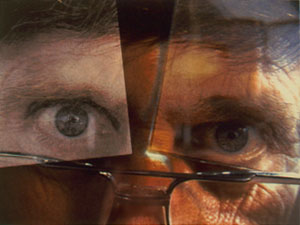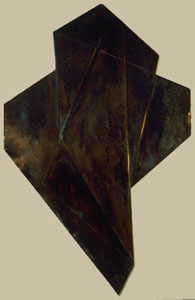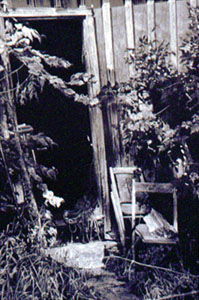








Fall 1999 Exhibition Schedule
| August 23 - September 15 |
1999 Fine Arts Faculty Exhibition |
October 13 |
UFO Pilgrimage Photographs by Bob DeBris |
| September 22 - October 13 |
The Sublime and the Ridiculous: Sculptures by Max Coots |
December 10 | Frank Owen/Amanda Means |
1999 Fine Arts Faculty Exhibition
- August 23 - September 15, 1999
- Related Educational Programs
The fine arts faculty present their work in the Gallery every other fall semester in such media as photography, drawing, painting, and sculpture. The current exhibition is organized by Roger Bailey, professor and chair of the department. Three of the artists have provided statements about their work, as follows:

1999, digital photograph, 7 1/2 x 9 1/2 inches
Roger Bailey
The work I am presenting here was play. I enjoyed every stage of creating it. In some ways this work is an example of the gap between the body and the mind. I began using the digital camera to make a photographic record of parts of my face. These images said something about how my particular face appeared from a particular camera angle in a particular light. As purely sensuous impressions, these images captured some sense of the real world, but they were rather unremarkable documents.
Then I became involved in the surprising and exciting act of translating those images, through intuition and reflection, into another state of existence. I made minor adjustments to the images in the computer and then printed each image twice: once on photographic paper and once on transparency film. By using the collage techniques of cutting, pasting, and layering, I created new forms that engaged my mind, and hopefully the mind of the viewer as well, in play, illusion, abstraction, and expression.
- RB

copper, 37 x 24 x 1 inches
J. Michael Lowe
I am a sculptor/designer. I make objects, which for want of a better term, are called sculpture. I believe they are devoid of any social or political content; my focus is the object. I am concerned with composition, form, space, line, texture, color, craftsmanship, and presentation, to mention but a few factors of construction. The works in this exhibition represent some recent efforts working in various metals, including copper, aluminum, and steel. I hope you will find my contribution to this faculty exhibition interesting, challenging, and thought-provoking. Your comments are always welcome.
- JML

digital image, 7 7/8 x 10 1/8 in.
Faye A. Serio
For me, photography has changed from a method of reproducing what the eye sees to a means of re-creating or re-presenting what the subject expresses. Using 35mm slides or negatives as stepping stones, I experiment with various techniques and materials to discover original ways to interpret each subject. Because of the methods and the types of paper used, all the images (except for the digital ones) are unique; unlike images in regular photography, they cannot be reproduced.
Images for the Lampson Falls series began as slides. I exposed each onto color Polaroid film, heated the Polaroid film until the emulsion (the actual image) was jelly-like, and then pulled it off its backing and placed it onto watercolor paper. I created waves and ripples by wrinkling and moving the image.
Images from Acoma Pueblo and Taos began as photographs. I coated canvas with primer, painted it with light-sensitive emulsion, and exposed and developed it as I would regular photographic paper. The rough texture of the canvas resembles the rough texture of the pueblo walls.
I hand-painted the images from Giverny, France—Monet's home. I intermingled and framed color with black and white to place emphasis on portions of the subject.
The digital images began as color prints. I scanned several photographs and then manipulated them on the computer to create each final image. The techniques I used included overlapping, layering, warping, altering color, and using transparencies. I printed the final images on watercolor paper.
- FAS
Guy Berard

acrylic on paper, 30 x 22 inches
Linda Strauss

photograph with hand drawing, 20 x 16 inches
Obiora Udechukwu

1998, acrylic and pencil on canvas,
36 x 24 inches
The Road to Roswell:
UFO Pilgrimage Photographs by Bob DeBris
- August 23 - October 13, 1999

Roswell, New Mexico, 1998, C print, 15 x 15 inches
Bob DeBris photographs "not only the events surrounding [the annual Roswell] UFO Encounter Festival, but also�strange and curious encounters—odd new realities made possible by mass culture, [including] the extraterrestrial image in advertising, space-themed diners, oddities and freak images, and [our] fascination with science fiction."
- Michael J. Riley, Ph.D., Roswell Museum and Art Center, NM
Q: "Why do you photograph this stuff?" A: "God only knows, people have passions."
Special thanks to Todd Matte '01 and Kirsha Frye '00 for wrangling with several paintbrush- and pizza-wielding minors: Emily Cania, Irene Carroll, Tosh ("I am GREAT at aliens!") Cornwell, Jessa Davis, Mary Davis, Kate Harloe, Ariana Hernandez, Willie Kahn, Caleb Whalen, and Nathan Whalen.
- Catherine Tedford and Carole Mathey
The Sublime and the Ridiculous:
Sculptures by Max Coots
- March 22 - April 17, 1998
- Related Educational Programs

Max Coots, Man with Head in His Hands,
1995, ceramic, 9 x 8 x 13 inches
Max Coots is probably best known for having been the Minister of the Canton Unitarian Universalist Church for 34 years from 1958 to 1992. Some may also know him from his published writings or from the years he was adjunct professor of sociology at Clarkson University. His sculptures may come as a surprise. Since retirement, he has been auditing sculpture, ceramics, and printmaking courses at St. Lawrence University under Michael Lowe and Roger Bailey. The artist writes:
My work is really play, and the exhibition title is quite apt. It reflects the whimsy, the playfulness, the seriousness, and the grotesqueness of one who comes to art-making late in life. There is a freedom in my sculptures to the extent that I am not building a career, an artistic reputation, nor defining myself by what I do. All that is in my professional past. My amateur present and the resulting "works" are, though I take the pieces and processes seriously, a romp with assorted materials, subjects, and moods, which, as you can see, are sometimes sublime, often ridiculous, and often flawed. I hope the viewer can be as relaxed about what they see as I was in the making.
- Max Coots
Lance Myler: He Quilts
- September 22 - October 13, 1999
- Related Educational Programs

The first time I met Lance Myler, he played one of Bach's "Preludes" on a 692-pipe organ that fills every square inch of the sunroom in his Victorian home in Potsdam, NY. Half a dozen children ranging from one to 15 years old careened in and out of the house, spraying several beautifully tended flower gardens, two cars, and each other with a hose. The older kids tended to the younger ones while Lance's wife Candy prepared dinner and juggled one of two little boys covered with pink spots on her hip. "You've had chicken pox already, right?" I wasn't exactly sure.
Having moved to northern New York a year ago, Lance teaches biology and chemistry at Canton College. He also sews gorgeous quilts. When we met, he pulled out dozens of them, scattering them on the floor and describing the hand sewing and machine techniques he incorporates—appliqué, tatting, marbleizing, crocheting, and knitting, among others. Some of the quilts were worn and faded with use and laundering. The smallest child crawled all over everything, oblivious to his father's careful needlework.
Each quilt had a story. An early quilt was pieced together from Candy's bridesmaids' dresses—red satin and dark green lace. In 1998, his "Easter Eggs" quilt won a blue ribbon at the local county fair and later went on the win first prize at the Michigan State Fair. That afternoon, Lance showed me a new quilt that he was working on, "Halloween." After our meeting, I was inspired by the artist's desire to create and give structure and meaning to a sometimes chaotic world.
- Catherine Tedford
Reconsidering Nature: Frank Owen/Amanda Means
A two-person exhibition curated by Nathan Farb
- October 21 - December 10, 1999
- Related Educational Programs
- Additional images from the exhibition
Amanda Means probes the very relationship between light and life itself. In her photographs, the subject appears to give birth and die at one and the same time.
Frank Owen examines the nature of cognition and knowledge. In his paintings, space and object simultaneously move forward and recede, while the material coalesces into order and concurrently disintegrates into chaos.
These are two artists with whom I have had wonderfully supportive friendships. They have influenced me, and each has altered the course of my work. To paraphrase Picasso, I respect those who I can steal from.
Amanda Means and Frank Owen are dedicated and serious contributors to the art world. It is our good fortune that they have been attracted to and work in the North Country. It has been a pleasure to curate this exhibition that I am sure will challenge, excite, and stimulate the St. Lawrence community.
- Nathan Farb
Amanda Means has been working in the field of photography for 20 years. She received a B.S. from Cornell University and a M.F.A. in photography from the Visual Studies Workshop in Rochester, NY. She has exhibited in numerous group and one-person shows in the United States, Canada, and England. Her work is in private, corporate, and museum collections including the Museum of Fine Arts, Houston, TX; the Museum of Photography, Film, and Television in Bradford, England; and the National Gallery of Canada in Ottawa. She has taught at the New School for Social Research, NYC; the International Center of Photography, NYC; and SUNY Plattsburgh. She is a professional black-and-white printer specializing in large photographs up to 50x60 inches. Her clients have included Robert Mapplethorpe and the Smithsonian Institution. She is a contributing editor for BOMB Magazine, a New York-based quarterly on culture. Her work is represented by Ricco/Maresca Gallery in New York City.
Frank Owen received both his B.A. and his M.A. from the University of California at Davis. His work has been shown in dozens of in solo and group exhibitions across the country and is included in such museum collections as the Corcoran Gallery of Art, Washington, DC; the Albright-Knox Art Gallery, Buffalo, NY; and the Fredrick R. Weisman Foundation of Art, Los Angeles, CA. He has taught at the University of Vermont in Burlington since 1992 and has been a visiting artist/lecturer at the University of North Carolina, Chapel Hill, and the School of Visual Arts in New York City. Frank Owen received two fellowships from the National Endowment for the Arts in 1978-79 and in 1989-90; more recently, he received a faculty development grant from UVM in 1993-94. His work is represented by Nancy Hoffman Gallery in NYC.

gelatin silver print, 60 x 50 inches
Our cobblestone farmhouse, built in the early 1880s, was constructed with small palm-sized stones naturally created by water from the shores of Lake Ontario. One hundred acres of apple trees surrounded it. The farm was in a rich agricultural area of Dutch farmers, a strip of land on the south shore of the lake, near the small town of Marion, New York. The area was a fruit belt of apple, peach, and cherry trees. In addition, there were areas with rich black soil good for growing celery, lettuce, cabbage, and carrots. Dairy farms were numerous. Over the years, our orchards were turned into pastures for dairy cattle. My sensibility as an artist is woven from a deep connection to this childhood on the farm. I slept in a tree house in summer and spent a great deal of time alone in the fields and woods. I built small nature worship shrines of sticks, mud, and stones.
Small farms cannot survive today. This is an era of agribusiness. In my childhood, farms were controlled and operated by one family. Enormous barns, empty and decaying relics of this time gone by, are scattered throughout the countryside in upstate New York.
I move to New York City to study art.
We lose our family farm.
My father dies.
As an art student, I loved the biomorphic paintings of Gorky, Pollock, and de Kooning, the early works of Rothko and Newman, and the paint-charged vista of surface, light, and color of Abstract Expressionism. The move to the largely man-made urban environment of New York City intensified my sense of loss of nature. My photographs of vegetation � plant forms and flowers � are a metaphor of this sense of bereavement.
I do not photograph these forms with a camera. The photographs are made placing a flower in the head of an enlarger. Light passes through both the flower and the lens to the paper surface. This is a different kind of light than the reflected light used by cameras containing film. The light of my photographs seems to emanate from the image itself, in much the same way as the light that comes from within the accumulations of paint in a painting.
- Amanda Means

acrylic and mixed media on canvas, 102" x 25'
My paintings are matrices of visual and physical events that occur in layers and varying scales, utilizing juxtapositions and overlays of painted and photographic images. A dependence upon an inquisitive, discursive collecting impulse involves making thousands of photographs and photocopies from multiple sources, excavating from information fields such as natural science, art history, science and technology, political history, and architecture. In many instances, these findings accumulate and build for years before precipitating into paintings. When that happens, the works occupy dense pictorial spaces that owe much to the influence of Abstract Expressionists upon my early development. These artists established a definition of painting that collects and represents fragmentary experience in a pictorial field similar to the way a mesh sieve collects and presents fragments of matter.
In the exhibition are three paintings with eccentric yet integral frames. The imagery includes fragments of halftone reproductions derived from books, magazines, technical journals, and catalogs. What interests me is accounting in some small way for the flood and flux of all of the print images I have been fascinated by since my earliest years. The other two large paintings, Pendulum and Corona/Carone, are a continuation of my attempts since 1971 to create a kind of abstract baroque pictorial space constructed of mark and image that come together in an imaginary depth possessing the verity of a photograph's finish.
The largest work in the exhibition, Floor of the Forest, 1990, was a response to the regional uproar that ensued following the publication of the recommendations of the Cuomo administration's 21st Century Commission on the Adirondacks. I covered the events of 1989-90 like a reporter, attending and photographing the meetings, conferences, rallies, protests, and hearings of all parties. The intention was twofold: to get me out of the studio and into the world and to set me in pursuit of a mutant species of socio-political Adirondack landscape painting to augment traditional "views" of the region.
- Frank Owen
All exhibitions and related educational programs are free
and open to the public. The Gallery welcomes individuals and groups for guided
tours; please call (315) 229-5174 for
information.
| Gallery hours | |
| Monday-Thursday Friday and Saturday |
12-8 p.m. 12-5 p.m. |
top of page